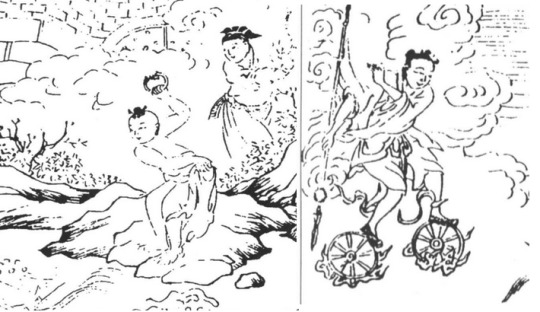#i am not an Adult Nezha Adaptation hater btw.. i just want to prove that 1. nezha is widely perceived as a child and/or youth
Explore tagged Tumblr posts
Note
is nezha eternally 12?
yeah he is he told me himself in a t&t parking lot
12 is an arbitrary number. if you're looking for a source that literally says the exact phrase "nezha is eternally 12" you're uhh probably not going to find one. you're also probably not going to find a source that outright states that he grew into an adult. i think the reason 12 has become a popular number is because it sort of straddles that point between true childhood and adolescence, but again, it's arbitrary.
in fsyy, nezha is 7 when the whole thing with ao bing and returning his flesh and bones to his parents happens, which as far as I'm aware is the last time that an exact age is given for him in that particular novel. fsyy is also not the end all be all of "canon", but it did have significant implications for both practiced religion and literature (1, ch.5). sangren also notes that 7 being the age given is important.
i've only read about half of jttw so far, but don't think any physical or chronological age is stated for him, except that sun wukong calls him "小哥" (little guy/young man/etc.) when they first meet lol.

(a couple of nezhas from this copy of fsyy)
but the exact number of 12 isn't the point behind the statement. imo the idea behind the sentiment is that nezha is culturally perceived as a child. he is metaphorically and literally associated with and representative of the traits and struggles of childhood. he is "the most popular and classic cultural image of child personification in the literature of China" (2). the portrayal of the child - what traits they embody, which authorities they subvert, how their agency develops and affects the world around them - will change with the sociopolitical environment of the country, and portrayals of nezha have always changed along with it, for the reason that his image is inextricable from that of a child's (3, 4). he is a representation, reflection, and symbolization of the youth.
(some media puts more emphasis than this on others, i.e. the songs used for the '03 cartoon opening and closing, which really emphasize him being little, being young (少年), and being the same age the presumably child singer (他的年纪跟我一般大) lol)
(this paper looks at the appearance of nezha in various medias for the past ~100 years, including adult portrayals, although it does make the assumption that adult actor = adult character and girl actor = girl character which is.. not really correct imo… also it includes 1979 nezha naohai as part of its 'adult image' era which is ????? so i would take its conclusions with a grain of salt and just look at its descriptions.)
you're also going to get a different answer if you look at it from a more religious viewpoint. as far as i know, he has religious iconography as both a child and as an adult, but his appearance is much more varied and doesn't necessarily have the same collective set of easily recognizable traits. here are some posts with artwork and statues of nezha (interspersed with some of hong hai'er): x y z.
however, the thing is that i don't think many modern adaptations can make the claim that they drew from a religious iconography basis more than they drew from the most popular cultural image of nezha. i then wish they would be more cognizant of the fact that, in the source from which they drew, nezha is most widely recognized as a kid, and treat that with respect.
obviously nezha is not always portrayed as a child. nezha is not always anything, there are just recurring visual and thematic elements that make him a cohesive and recognizable figure, i.e. the twin buns, the iconic weapons, the lotus imagery. being a child or a youth is also one of these things, and its significance, imo, is well analysed and documented.
at the end of the day this answer is only so long-winded because it's the internet. go text your parents and ask them how old they think nezha is.
#nezha#i do think of him as a kid#i am not an Adult Nezha Adaptation hater btw.. i just want to prove that 1. nezha is widely perceived as a child and/or youth#and 2. this image is significant culturally and thematically#i am the silly jokes guy but writing this was kind of fun..#i think it's a little weird if you're like super fixated on either proving or disproving the exact number of 12#i also think it's completely reasonable for people who grew up with nezha to be uncomfortable with certain treatments of him#ask
126 notes
·
View notes